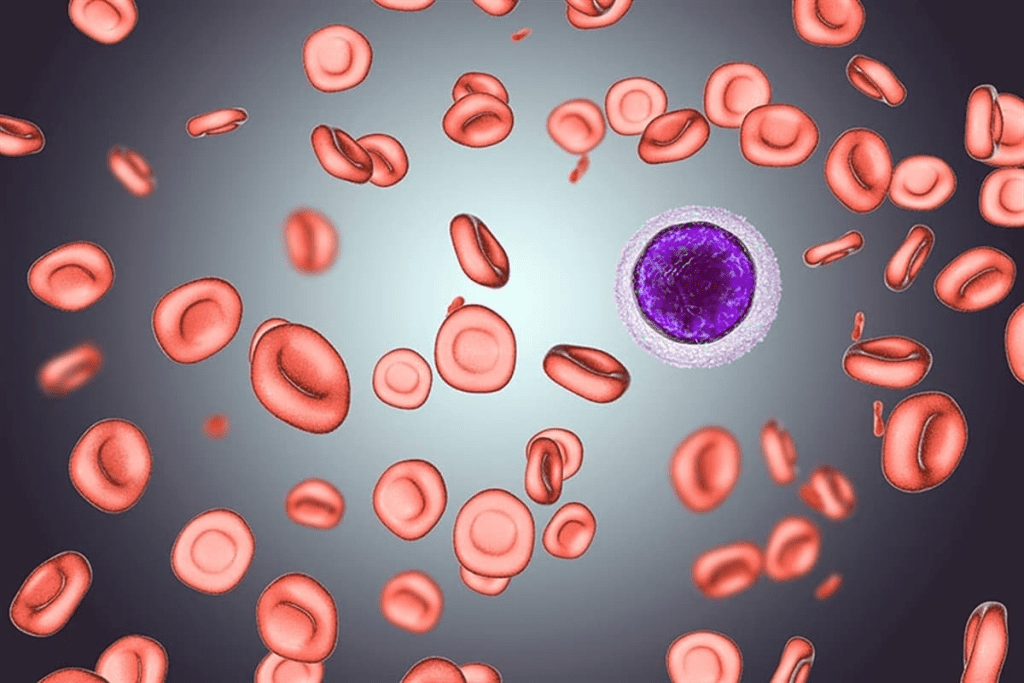Last Updated on November 13, 2025 by
Do iron supplements help? Explore hemolytic anemia treatment options and positive new strategies for managing this condition. Powerful guide to better health.
Hemolytic anemia is when red blood cells get destroyed too quickly. Iron supplements are often used to treat iron deficiency anemia. But, their role in hemolytic anemia is more complex.

We will look into when iron supplements might help or harm. Usually, iron supplements are not the first choice for treatment of hemolytic anemia. They are only suggested if there’s also iron deficiency.
Hemolytic anemia is when red blood cells break down too early. This happens when they are destroyed faster than they can be replaced. As a result, the body doesn’t have enough healthy red blood cells.

Hemolytic anemia is about the premature destruction of red blood cells. This can happen inside or outside the blood vessels. The reasons for this destruction are complex and varied.
Many things can start this process, like genetic disorders, infections, and autoimmune diseases. Knowing what causes it is key to treating it well.
Intravascular hemolysis happens when red blood cells are destroyed inside the blood vessels. This can be due to mechanical heart valves or paroxysmal nocturnal hemoglobinuria. Extravascular hemolysis, on the other hand, occurs outside the blood vessels, often in the spleen. It’s linked to hereditary spherocytosis or autoimmune hemolytic anemia.
The symptoms of hemolytic anemia vary based on the cause and severity. Common signs include fatigue, shortness of breath, and pale skin. These symptoms come from not enough red blood cells to carry oxygen.
Other symptoms might be jaundice, dark urine, and an enlarged spleen. In serious cases, it can cause heart issues or a hemolytic crisis. This is a medical emergency.
Hemolytic anemia is a group of disorders where red blood cells are destroyed too early. This can happen due to genetic or environmental factors. Knowing the different types and causes helps doctors find the right treatment.
Inherited hemolytic anemias come from genetic mutations. Common conditions include sickle cell anemia and thalassemia. These are caused by specific genetic defects.

Acquired hemolytic anemias are caused by external factors. These include infections, medications, and autoimmune disorders. These factors lead to the early destruction of red blood cells.
Autoimmune hemolytic anemia is when the immune system attacks and destroys red blood cells. Treatment for AIHA often involves immunosuppressive therapy. This reduces the immune system’s attack on red blood cells.
Managing AIHA may start with corticosteroids. Other immunosuppressive agents are considered if the condition doesn’t improve.
Iron metabolism is key in managing hemolytic anemia. Iron is essential for making hemoglobin, which carries oxygen in red blood cells. We will look at how iron metabolism changes in hemolytic conditions.
In a healthy person, iron metabolism is well-controlled. The body reuses iron from old red blood cells to make new ones. This process involves hepcidin and ferritin, important for iron use.
Healthy iron cycling keeps red blood cells in good shape. Most of the body’s iron goes into hemoglobin. The balance of iron absorption, storage, and use is complex.
Hemolytic anemia messes with this balance by destroying red blood cells. This releases iron into the blood, causing iron overload. Too much iron can harm organs like the heart and liver.
In hemolytic anemia, red blood cell destruction raises indirect bilirubin and LDH (lactate dehydrogenase) levels. It’s important to manage iron levels to avoid damage.
It’s hard to measure iron levels in hemolytic anemia patients because of iron level changes. Tests like serum ferritin, transferrin saturation, and serum iron levels help doctors understand iron status. These tests guide treatment plans.
Knowing these values is vital for managing iron in hemolytic anemia patients. By monitoring iron levels, doctors can tailor treatments. This improves outcomes and lowers the risk of complications.
Hemolytic anemia is a tricky condition when it comes to iron status. It requires a careful look at how iron is used and available in the body. This is because the ongoing breakdown of red blood cells messes with iron levels.
In hemolytic anemia, iron levels can seem high because of red blood cell breakdown. This releases iron into the blood, making it seem like there’s enough. But, as a hematologist notes, “This doesn’t always mean the body has enough iron for making new red blood cells.”
“Iron overload can occur in hemolytic anemia, if frequent transfusions are needed.”
Red blood cell breakdown puts more iron into the blood. This can make serum iron levels seem high. But, it might not show the real iron stores or how much iron is available for making new red blood cells.
Even with high iron levels, some people with hemolytic anemia might have iron deficiency. This can happen if there’s chronic blood loss or the body is making more red blood cells than usual. Research shows that “some patients with hemolytic anemia may develop iron deficiency due to chronic blood loss or increased erythropoiesis.”
It’s important to spot these cases because iron deficiency can make anemia worse. A detailed check of iron status is needed to diagnose and treat iron deficiency properly.
Getting iron status right is key in hemolytic anemia. Tests like serum iron, total iron-binding capacity (TIBC), and ferritin levels are used. These tests help doctors understand iron use and find any problems.
For example, low ferritin levels mean iron deficiency, even with hemolysis. High ferritin levels might show iron overload, which is common in patients who get many blood transfusions.
By looking closely at these lab results, doctors can decide on the right treatment for iron issues.
Iron supplements in hemolytic anemia are a complex topic. They are used to treat many anemias but not all. Hemolytic anemia is different because of its unique causes.
Many studies have looked into iron supplements for hemolytic anemia. Key findings are:
Wrong iron supplements in hemolytic anemia can be risky. The main worry is iron overload. This can harm organs like the heart, liver, and pancreas.
Iron overload can cause serious problems. These include:
So, it’s very important to check if iron supplements are needed in hemolytic anemia. We must also watch the patient’s iron levels closely to prevent these serious issues.
In patients with hemolytic anemia, iron supplements are not always the answer. But they can be helpful when true iron deficiency is confirmed. Hemolytic anemia is a condition where red blood cells are destroyed too early. This can lead to problems with iron metabolism.
It’s important to confirm iron deficiency in patients with hemolytic anemia before starting iron supplements. Laboratory tests are key in this diagnosis. Serum ferritin and transferrin saturation are important to check iron levels.
Serum ferritin shows how much iron the body has. Transferrin saturation shows how much iron is being used. In hemolytic anemia, these can be tricky to read because of the red blood cell destruction.
To start iron supplements, certain lab results must be met. These include:
If these results are seen, iron supplements are likely to help.
After starting iron supplements, it’s important to watch how the patient responds. This means regular blood tests to check:
By watching these closely, doctors can make any needed changes to iron therapy. This helps ensure the best treatment results.
Hemolytic Anemia Treatment involves several steps, based on the cause. It’s important to know the different ways to manage it.
Finding and treating the root cause is the first step. This might mean managing autoimmune diseases, stopping certain medications, or treating infections. “The key to successful treatment lies in accurately diagnosing the cause of hemolytic anemia,” experts say.
For autoimmune hemolytic anemia (AIHA), doctors might use immunosuppressive therapy. This helps lower the body’s attack on red blood cells. Inherited conditions like sickle cell disease need different care, like supportive treatments and managing complications.
Corticosteroids are often the first treatment for many hemolytic anemia cases, like AIHA. They help by reducing the immune system’s attack on red blood cells. A study found that corticosteroids can help reduce hemolysis in AIHA patients.
If corticosteroids don’t work, doctors might use immunosuppressive therapy. This treatment suppresses the immune system more, helping to reduce red blood cell destruction. But, it also has risks and needs close monitoring.
In some cases, removing the spleen (splenectomy) is recommended. The spleen is where red blood cells are often destroyed in hemolytic anemia. “Splenectomy can be an effective treatment for certain patients with hemolytic anemia,” doctors say.
Other surgeries might be needed based on the cause of the condition. For example, if there’s a physical blockage or damage to red blood cells, surgery might fix it.
In summary, treating hemolytic anemia needs a personalized plan. Knowing the different treatments helps doctors create effective care plans for better patient outcomes.
Patients with chronic hemolytic conditions face ongoing challenges. They need careful management to prevent complications and enhance their quality of life. Chronic hemolytic anemia requires unique monitoring and tailored interventions.
Managing chronic hemolytic anemia effectively involves regular monitoring. This helps detect complications early. Key aspects include:
Regular follow-up appointments with a healthcare provider are essential. They help adjust treatment plans and address emerging issues promptly.
Chronic hemolytic conditions can lead to complications like gallstones, splenomegaly, and pulmonary hypertension. Managing these complications often requires a team effort. Specialists such as hematologists, surgeons, and others are involved.
For example, patients with recurrent gallstones might need surgery. Those with significant splenomegaly could benefit from splenectomy in some cases.
While iron supplements are sometimes needed, patients with chronic hemolytic anemia require more. This includes:
Nutritional counseling can help patients make informed dietary choices. This supports their condition management.
In conclusion, managing chronic hemolytic conditions requires a holistic approach. This includes long-term monitoring, managing complications, and nutritional support. By focusing on the whole patient, healthcare providers can significantly improve outcomes and quality of life.
Patients with hemolytic anemia are key in managing their condition. They need to understand their disease and watch for signs of trouble. This way, they can work well with their doctors to get the best care.
Knowing about lab results is vital for managing hemolytic anemia. Patients should keep an eye on their hemoglobin levels and bilirubin counts. It’s important to ask their doctors to explain these results clearly.
Lab results show how severe the condition is. A big drop in hemoglobin levels might mean a hemolytic crisis. This is a serious situation that needs quick medical help.
A hemolytic crisis is a serious problem in hemolytic anemia. It happens when red blood cells break down fast. Patients should know the signs, like severe anemia, jaundice, and dark urine.
If patients see these signs, they should get medical help right away. Quick action can prevent serious problems.
What patients eat is important for managing hemolytic anemia. They should know which foods help and which might make things worse. Some foods can help make more red blood cells, while others might get in the way of treatment.
Supplements should be used carefully. Patients should talk to their doctors before taking any. A balanced diet is best for overall health.
Patients with hemolytic anemia can improve their lives by being informed and active. We stress the need for ongoing education and support in caring for this condition.
Managing hemolytic anemia requires a detailed plan. This plan includes checking iron levels and giving the right treatment. Iron is key in treating this condition, helping avoid serious problems and improving health.
When thinking about iron pills, we must be careful. We need to know the patient’s iron levels and the chance of too much iron. Our talk shows the importance of knowing how iron works in these conditions. This ensures iron pills are used right and safely.
In short, treating hemolytic anemia well means looking at iron closely. It’s about more than just iron pills. By focusing on iron, doctors can give better care. This care helps patients with hemolytic anemia live better and feel better.
Hemolytic anemia is when red blood cells break down too early. This can happen inside or outside the blood vessels.
Symptoms include feeling tired, jaundice, dark urine, and pale skin. You might also have shortness of breath and a fast heartbeat. How bad these symptoms are depends on the cause and how fast red blood cells are being destroyed.
Iron supplements might help if you also have iron deficiency. But, they can cause iron overload if you’re losing blood cells fast. Always check your iron levels first.
Doctors use tests like serum ferritin and transferrin saturation to check iron levels. Sometimes, they might do a bone marrow biopsy too.
Too much iron can harm your organs. It can also make losing blood cells worse. Always talk to your doctor before taking iron supplements.
Doctors usually start with corticosteroids to stop the immune system from attacking red blood cells. Sometimes, they use other medicines or even remove the spleen if needed.
Avoid foods high in iron or vitamin C, as they can affect how your body absorbs iron. Also, don’t take supplements that could interfere with your treatment.
Know the signs of a crisis, like severe jaundice, fast heartbeat, and extreme tiredness. If you see these, get help right away.
Removing the spleen might be an option if it’s destroying too many red blood cells. It’s usually a last resort when other treatments don’t work.
Long-term care includes regular check-ups, managing problems, and getting enough nutrients. It’s also important to learn how to take care of yourself and when to seek help
Subscribe to our e-newsletter to stay informed about the latest innovations in the world of health and exclusive offers!